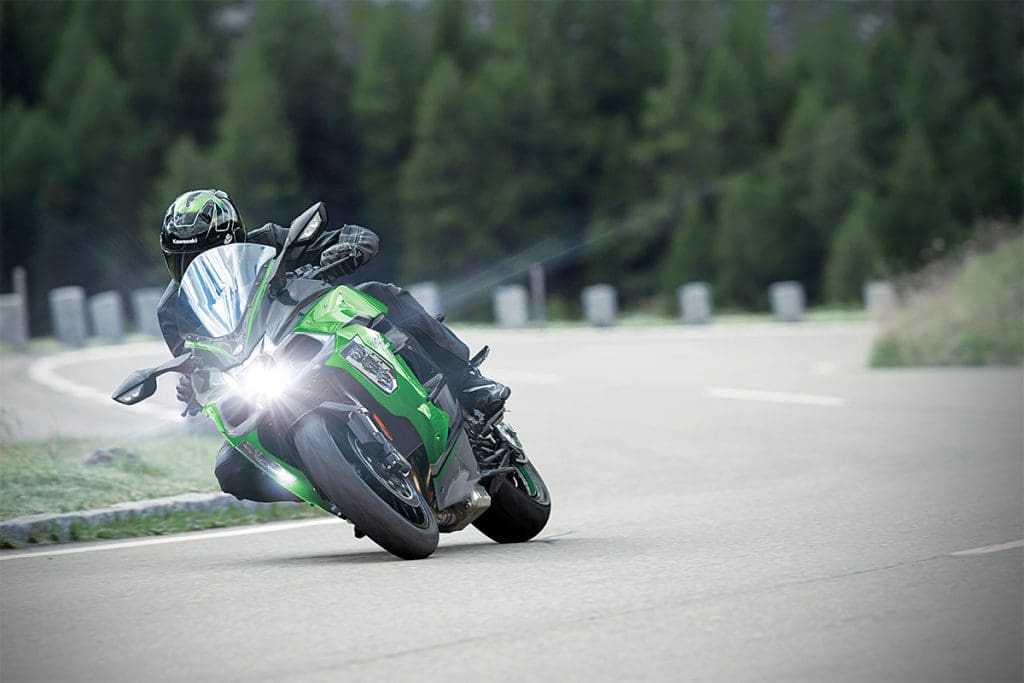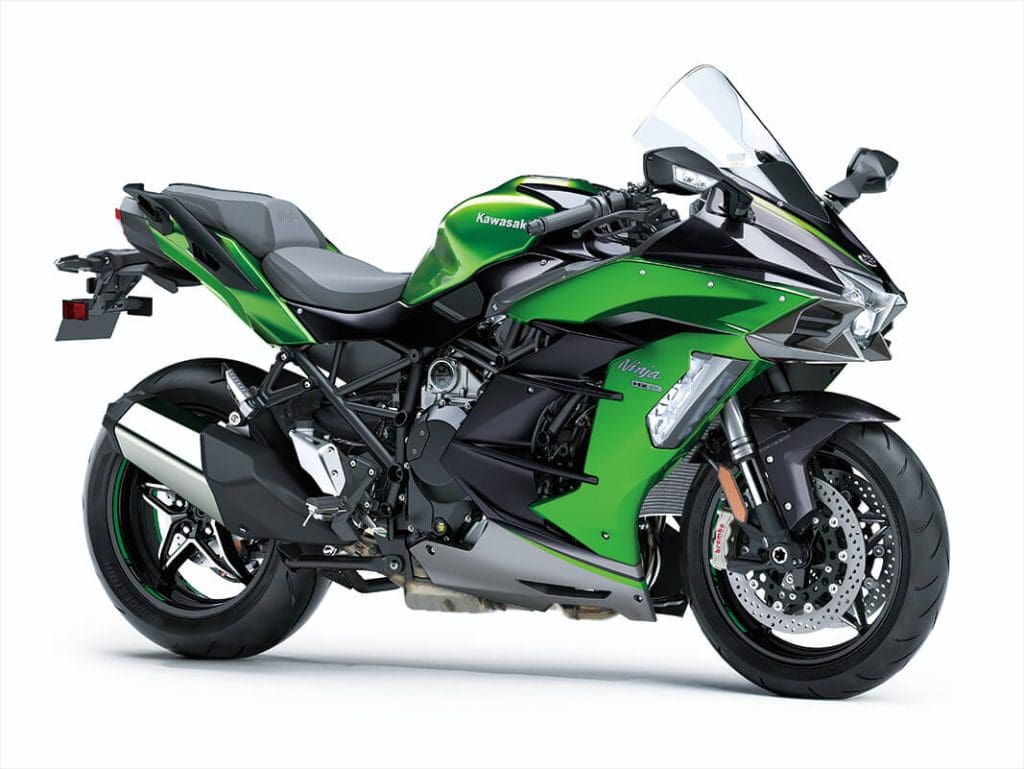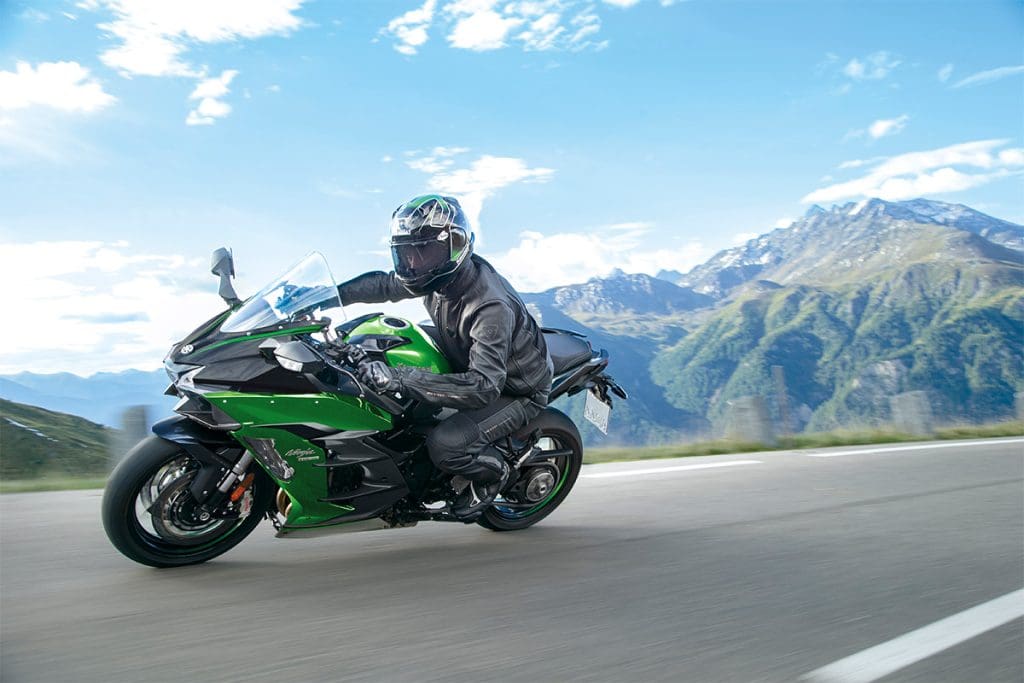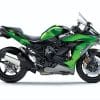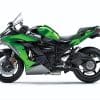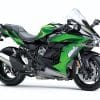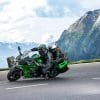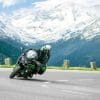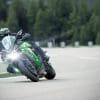Supercharged Sport Touring: The 2021 Kawasaki Ninja H2 SX+ SE
Contents
It just makes sense. When you are the Japanese brand with a 2021 lineup full of performance bikes, of course you are the manufacturer with the most ferocious sport-touring bike available!
Being part of the Japanese-made Ninja family provides access to the best of the best parts choices. Like the others in the 2021 Kawasaki H2 family, the SX+ SE shares a version of the engine, trellis frame, suspension, and braking systems. At first glance, they all appear identical, but Kawasaki Motorcycles has made small changes that turn the H2 SX+ SE into a very luxurious performance touring platform.
Powered by a supercharged, 998cc, liquid-cooled, 4-stroke DOHC 16-valve In-line four-cylinder engine, making 210.0 HP (157.0 kW) @ 11500 RPM, and 114.7 Nm (84.6 lb-ft) @ 11,500 rpm of torque, this Kawasaki provides ample thrust to carry pilot and passenger at very illegal speeds.
The trellis frame sits a bit taller and lengths the wheelbase to 1,480 mm (58.3 in), improving the 2-up capabilities, and space for a nicer pillion pad. The overall weight of the H2 SX+ SE seems a bit rotund at 262 kg (578 lb), but all riding impressions share how it feels so well balanced and nimble on its Bridgestone Battlax tires.
The braking system is another piece of high tech Kawasaki provides with the Brembo Stylema calipers, and the KIBS (Kawasaki Intelligent Anti-lock Brake System). This is a welcome addition for consistent, powerful stops when you are at highway speeds with the option 28-liter quick-release panniers filled for the weekend.
Overall the H2 SX+ SE is unchanged from 2020. It remains a supercharged Sport Touring missile. Yes, it has a lofty price tag, but damn you get a lot of kit for the dollars.
The 2021 Kawasaki Ninja H2 SX+ SE starts at $25,500 USD / $29,199 CAD
On this page: we’ve curated specs, features, news, photos/videos, etc. so you can read up on the new 2021 Kawasaki Ninja H2 SX+ SE in one place.
Model Overview
General Info
- Price: $25,500 USD / $29,199 CAD
- Key Features:
-
- Electronic Cruise Control
- Kawasaki Corner Management Function (KCMF)
- Kawasaki Quick Shifter (KQS)
- Kawasaki Launch Control Mode (KLCM)
- Kawasaki Electronic Control Suspension (KECS)
- Touring Capability
Main Specs
- Engine: 998cc Liquid-cooled, 4-stroke, In-Line Four, DOHC, 16-valve
- Power: 228.0 HP (166.4 kW) @ 11500 RPM
- Torque: 141.7 Nm (104.9 ft.lbs) @ 11000 RPM
- Wet Weight: 524.8 lbs (238.1 kg)
- Seat Height: 32.5 inches (825.5 mm) at the lowest point
Competitors
2021 Kawasaki Ninja H2 SX+ SE Specifications
ENGINE |
||
| Engine | 998cc, liquid-cooled, 4-stroke, DOHC 16-valve in-line four | |
| Power | 228 Hp | |
| Bore x Stroke | 76.0 x 55.0mm | |
| Compression Ratio |
11.2:1
|
|
| Fuel System | Fuel injection: ø40 mm x 4 with dual injection | |
| Starter | Electric | |
| Lubrication | Forced lubrication, wet sump with oil cooler | |
DRIVETRAIN |
||
| Clutch | Wet multi-disc, manual | |
| Transmission | 6-speed, return, dog-ring | |
| Final Drive | Chain | |
CHASSIS |
||
| Suspension Front | ø43 mm inverted fork with KECS-controlled compression and rebound damping, manual spring preload adjustability, and top-out springs / 120 mm (4.7 in) | |
| Suspension Rear | New Uni Trak, BFRC lite gas-charged shock with piggyback reservoir, KECS-controlled compression and rebound damping, and electronic spring preload adjustability / 139 mm (5.5 in) | |
| Brakes Front | Dual semi-floating ø320 mm discs with radial-mount, Brembo Stylema monobloc, opposed 4-piston calipers | |
| Brakes Rear |
ø250 mm disc with 2-piston caliper
|
|
| Tires Front | 120/70ZR17M/C (58W) | |
| Tires Rear | 190/55ZR17M/C (75W) | |
| Fuel Tank Capacity | 19 litres | |
| Color |
Emerald Blazed Green / Metallic Diablo Black / Metallic Graphite Gray
|
|
ELECTRICAL |
||
| Ignition | Digital | |
| Spark Plugs | ||
| Headlight | LED | |
| Tail Light | LED | |
DIMENSIONS |
||
| Overall Length | 84.1 in | |
| Overall Width | 30.5 in | |
| Overall Height | 49.6 in | |
| Wheelbase | 1,480 mm (58.3 in) | |
| Ground Clearance | 130 mm (5.1 in) | |
| Seat Height | 835 mm (32.9 in) | |
| Curb Weight | 262 kg (578 lb) | |
WARRANTY |
||
| Warranty | 12 months | |
| Kawasaki Protection Plus | 12 / 24 / 36 / 48 months | |
2021 Kawasaki Ninja H2 SX+ SE Features
Assist & Slipper Clutch
Based on feedback from racing activities, the Assist & Slipper Clutch uses two types of cams (an assist cam and a slipper cam) to either drive the clutch hub and operating plate together or apart.
Under normal operation, the assist cam functions as a self-servo mechanism, pulling the clutch hub and operating plate together to compress the clutch plates. This allows the total clutch spring load to be reduced, resulting in a lighter clutch lever feel when operating the clutch.
When excessive engine braking occurs – as a result of quick downshifts (or an accidental downshift) – the slipper cam comes into play, forcing the clutch hub and operating plate apart. This relieves pressure on the clutch plates to reduce back-torque and helps prevent the rear tire from hopping and skidding. This race-style function is particularly useful when sport or track riding.
Economical Riding Indicator
While effective vehicle speed and engine speed may vary by model, paying attention to conditions that cause the “ECO” mark to appear can help riders improve their fuel efficiency – a handy way to increase cruising range. Further, keeping fuel consumption low also helps minimize negative impact on the environment.
Electronic Throttle Valves
Electronic throttle valves also enable more precise control of electronic engine management systems like S-KTRC and KTRC, and allow the implementation of electronic systems like KLCM, Kawasaki Engine Brake Control, and Electronic Cruise Control.
Kawasaki Engine Brake Control
KLCM (Kawasaki Launch Control Mode)
KCMF (Kawasaki Cornering Management Function)
• S-KTRC/KTRC (including traction management and wheel lift management)
• KLCM (including traction management and wheel lift management)
– Designed to optimize acceleration from a stop
• KIBS (including pitching management and corner braking management)
• Kawasaki Engine Brake Control
KTRC (Kawasaki Traction Control)
Less intrusive modes maintain optimum traction during cornering. Designed with sport riding in mind, they facilitate acceleration out of corners by maximizing forward drive from the rear wheel. And because Kawasaki’s sophisticated software bases its dynamic analysis on the chassis’ orientation relative to the track surface (rather than relative to a horizontal plane), it is able to take into account corner camber, gradient, etc., and adapt accordingly.
In the more intrusive modes (and for some models, in any mode), when excessive wheel spin is detected, engine output is reduced to allow grip to be regained, effectively enabling riders to negotiate both short, slippery patches (train tracks or manhole covers) and extended stretches of bad roads (wet pavement, cobblestone, gravel) with confidence.
Models equipped with IMU incorporate chassis-orientation feedback to offer even more precise management.
Smartphone Connectivity
Supercharged Engine
One of the greatest benefits of designing the supercharger in-house and tailoring its design to match the engine’s characteristics was that engineers were able to achieve high-efficiency operation over a wide range of conditions – something that would not have been possible by simply dropping in or trying to adapt an aftermarket automotive supercharger.
The importance of high efficiency in a supercharger is that, as the air is compressed, power-robbing heat gain is minimal. And while many superchargers are able to offer high-efficiency operation in a very limited range of conditions, the Kawasaki supercharger offers high efficiency over a wide range of pressure ratios and flow rates – meaning over a wide range of engine speeds and vehicle speeds. This wide range of efficient operation (similar to having a wide power band) easily translates to strong acceleration. The supercharger’s high efficiency and minimal heat gain also meant that an intercooler was unnecessary, greatly saving weight and space, and enabling the engine’s compact design.
ELECTRONIC CRUISE CONTROL
POWER MODES
KQS (KAWASAKI QUICK SHIFTER)
2021 Kawasaki Ninja H2 SX+ SE Photos
2021 Kawasaki Ninja H2 SX+ SE Videos
Links
Kawasaki Official Websites



